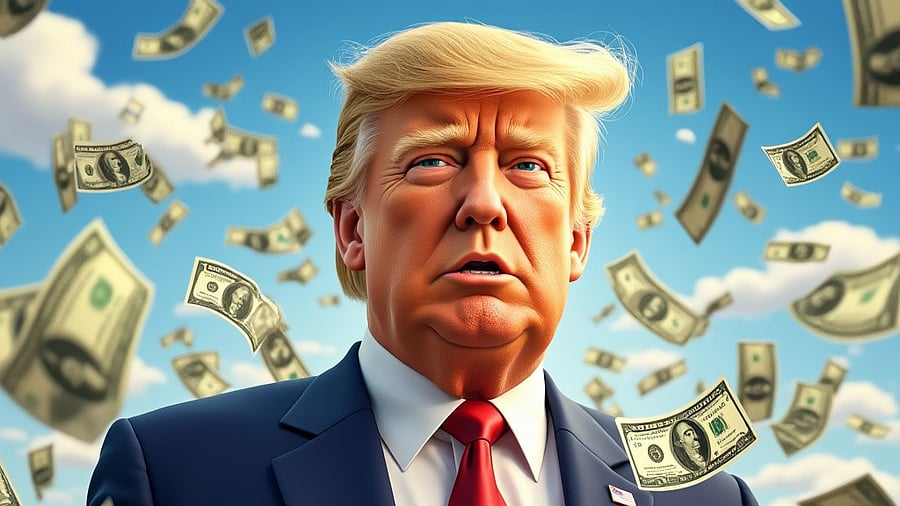
Image for representation.
Credit: Grok
By Robert Burgess
Hedge fund manager Scott Bessent, reported to be in line for a top job in the Trump administration such as Treasury secretary or Federal Reserve chair, wrote in a Wall Street Journal op-ed on Monday that the reactions in financial markets to the Nov. 5 elections “prove” investors’ “unambiguous embrace of the Trump 2.0 economic vision.” Well, they certainly prove equity investors like the idea of lower tax rates and less regulation. Beyond that, it’s unclear what they prove, and the clock is ticking for Donald Trump and his surrogates to provide answers to some critical questions around economic policy.
Just look at the government bond market, which is the benchmark for the global financial system, and the dollar, by far the world’s primary reserve currency. These markets signal that the warnings of faster inflation from economists who have analyzed the policies of a proposed Trump administration are all too real. And that means interest rates will be higher for longer, and tighter financial conditions will restrain the economy.
A reckoning may be in store for equity investors if Trump or his surrogates don’t soon provide the specifics of his plan to carry out a potentially costly trade war and the mass deportation of millions from the labor force without triggering inflation. What investors have heard so far is vague and contradictory. For example, Trump wants to boost the economy with tariffs, but doing so is widely expected to reignite inflation. He also wants to deport millions of immigrants, but that also threatens to reignite inflation. “Soon enough, the stock market will have to look past the promise of tax cuts and deregulation to assess just how disruptive Team Trump will be in their second term,” Christopher Smart, managing partner of Arbroath Group and a former Treasury Department official in the Obama administration, wrote in a Nov. 11 Substack missive.
The bond market’s concern is evident. The average yield on US Treasury securities, which is used to help set the rate at which businesses and consumers can borrow, reached 4.40 per cent on the day after the election, the highest since July, before easing back to 4.31 per cent at the end of last week, based on the Bloomberg US Aggregate Treasury Index. That represents a surge of about 0.8 per cent percentage point since mid-September, a rise that coincided with improved odds of Trump being re-elected.
What’s remarkable about this move is that it came even after the Fed cut its main interest rate by half a percentage point in September, and by an additional quarter of a percentage point last week. Why did market rates rise as the Fed lowered policy rates? Again, because of the outlook for faster inflation. The derivatives market shows that traders see inflation reaccelerating over the next two years, and investors will demand higher yields expecting inflation to erode the value of bonds’ fixed-interest payments over time, making the securities worth much less.
Never mind the tariffs; Trump’s most inflationary proposal, as the macroeconomic strategists at TS Lombard see it, is probably his plan for mass deportations. Here’s how the firm’s Dario Perkins put it in a research note Monday:
The reason is simple – strong immigration was one of the big things that made central banks (not just the Fed) much more relaxed about underlying price dynamics. It helped solve post-Covid labor shortages (not just in the US). Sending millions of people back to their country of origin would reverse those trends and – depending on how many people were deported – recreate the situation we were in two years ago.
And what was that situation? It was a massive labour shortage that forced companies to bid up wages to keep employees and attract new workers, which contributed to inflationary pressures. Economists referred to this as the “wage-price spiral,” where companies passed on higher labor costs to consumers in the form of increased prices for goods and services. But many consumers now say they are tapped out and have to rely on credit cards or “buy now, pay later” plans to afford daily essentials like food, clothing and shelter. Indeed, a Fed study last month found that the consumers powering the economy are increasingly those who are higher up the income ladder.
This brings us to the dollar, which has surged to the strongest level against its major peers in more than a year. A rising currency would normally be a sign of confidence in America, but the recent move, like the one in Treasuries, is all about expectations for faster inflation and interest rates that stay higher for longer. Besides, this is the opposite of what Trump has said he wants — an appreciating dollar makes US exports more expensive to our foreign customers. Every 10 per cent rise in the value of the dollar reduces earnings for members of the S&P 500 Index by about 3 per cent, economists at Bank of America Corp. estimated earlier this year.
But that pales in comparison to the real concern when it comes to the dollar: a crisis of confidence in America as a stable place to invest, brought on by erratic and unpredictable domestic and foreign policies, and an administration that periodically undermines the rule of law. That’s exactly what happened during Trump’s first term, when the dollar’s share of global currency reserves tumbled from 65.4 per cent when he took office at the start of 2017 to 60.7 per cent when he left at the end of 2020, the lowest since 1995. Under Biden’s steady approach to policy, the dollar’s share has largely stabilized, amounting to 58.2 per cent at the end of the second quarter.
The stock market hogs all the headlines, but better gauges on how markets are interpreting Trump 2.0 can be found in the bond and currency markets. Ignore them at your peril.